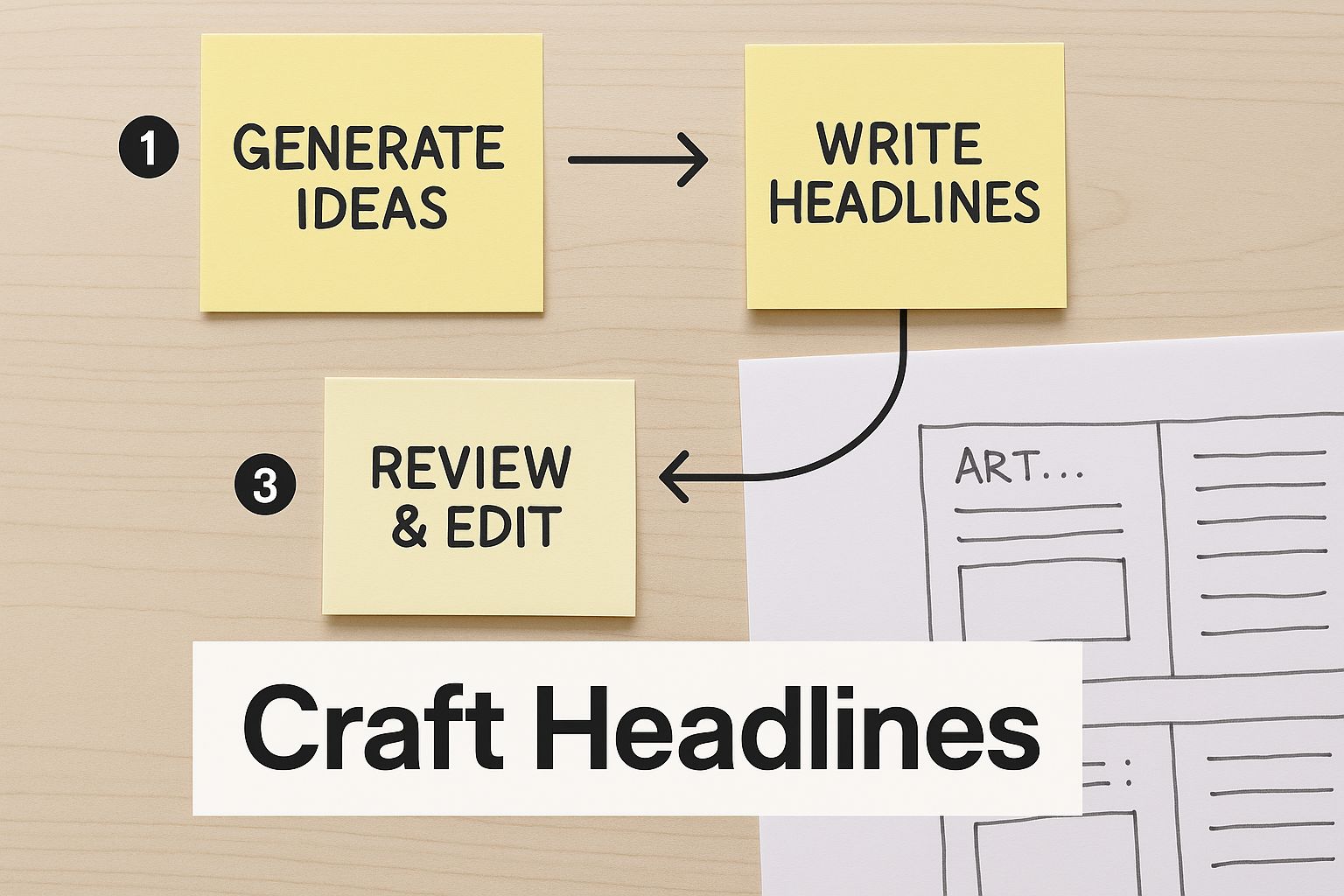Table of Contents
So, you want to get into copywriting? Great choice. At its core, copywriting is the art and science of using words to get people to take action. It’s not just about crafting pretty sentences; it’s about understanding people and motivating them to click, buy, subscribe, or engage.
Think of it as salesmanship in print. It’s one of the most vital skills any business can have in its corner.
What a Modern Copywriter Actually Does

When you're just starting, the world of copywriting can seem massive. But don't let that intimidate you. A copywriter is essentially a problem-solver who uses words to bridge the gap between a business's goals and a customer's needs.
Businesses are always looking for skilled writers who can cut through the noise. They need people who can take a complicated product or a simple idea and turn it into a clear, compelling message that resonates with an audience and, ultimately, drives results.
Core Copywriting Formats for Beginners
To give you a better idea of what you might be working on, I've put together a quick table outlining the most common types of copywriting you'll encounter. Each one has a different purpose and shows up in different places.
This is just a starting point, of course, but mastering these formats will give you a solid foundation for your career.
A Day in the Life of a Copywriter
No two days are exactly alike, which is part of the fun. One day you might be crafting snappy, persuasive copy for a Facebook ad campaign. The next, you could be diving deep into a company’s voice to write their entire "About Us" page.
Each format demands a unique touch, but the goal is always persuasion. Here’s a closer look at what that involves:
- Website Copy: This is all about telling a brand's story and guiding visitors. You’ll write the text for homepages, product descriptions, and landing pages.
- Email Campaigns: You'll be in your customer's inbox, writing newsletters and promotional emails designed to build relationships and drive sales. For a deep dive, check out this comprehensive guide to cold email copywriting.
- Social Media Ads: This is where you learn to be concise and impactful. The copy needs to stop someone mid-scroll and make them want to learn more.
- Blog Posts: This is long-form content. You'll write articles that educate your audience, establish the brand as an expert, and help the site rank higher on Google.
A Booming, Flexible Industry
One of the best things about copywriting is the opportunity it offers. You can work in-house for a major brand or enjoy the freedom of freelancing. In fact, freelancing is the path for the majority of writers—a massive 59% of copywriters are their own boss.
The demand is definitely there. The global copywriting services market hit $25.29 billion in 2023 and is only expected to climb. This isn't a fleeting trend; as long as businesses exist online, they will need skilled writers to help them grow.
With this foundation, you have a real-world picture of the copywriting industry. Think of this as your launching pad for turning a passion for writing into a rewarding and in-demand career.
Understanding the Psychology of Good Copy
Great copywriting has very little to do with being a clever wordsmith. It’s really about getting inside your reader's head. Before you even think about writing a headline, you need to understand who you're talking to on a deeply human level. This means going way beyond basic demographics and uncovering their real-world frustrations, their secret ambitions, and what truly motivates them.
Effective copy always feels like a one-on-one conversation. It builds a genuine connection by showing the reader that you get them and their problems. This is the one skill that separates copywriters who just list product details from those who actually inspire people to act.
Features Tell, But Benefits Sell
If there's one concept that will fundamentally change your writing, it's the difference between features and benefits. It sounds simple, but once you truly master this, your copy will become exponentially more powerful.
- A feature is a factual detail about your product. Think specs. For example, "This laptop has a 16-hour battery."
- A benefit is the positive experience or emotional payoff the customer gets from that feature. For instance, "Work from anywhere all day long without ever stressing about finding an outlet."
Features speak to our logical brain, but benefits tap into emotion—and people almost always make decisions based on emotion. Your job is to act as a translator, turning every dry technical spec into a tangible, desirable outcome for your reader.
From a Spec Sheet to a Compelling Story
Let's see how this works in the real world. Imagine you're writing copy for a new project management tool. The development team hands you a list of features:
- AI-powered task categorization
- Shared team calendars
- Real-time progress dashboards
A rookie copywriter might just present this list as is. But a pro digs deeper to find the story behind the specs. They translate those features into benefits that solve a real problem.
You can feel the difference, right? The benefit-driven copy speaks directly to common pain points—wasted time, miscommunication, and project anxiety—and positions the tool as the clear solution. Honing this translation skill is a core part of building a solid content creation workflow for better results.
How Persuasion Evolved for the Digital Age
This focus on psychological triggers isn't a new trick, but the way we use it has changed dramatically. The internet's commercial boom in the mid-1990s was the real turning point. When businesses were first allowed online in 1995, it kicked off a marketing revolution. The launch of Amazon and eBay that same year, followed by Google in 1996, created entirely new playing fields for persuasive writing.
Copywriting had to adapt from the world of print and TV to the interactive, fast-paced environment of websites, emails, and social media. With over 347 billion emails now sent every single day, the ability to write copy that forms an instant connection is more critical than ever. You can read more about this shift in the evolution of the copywriting industry.
This history lesson shows exactly why understanding reader psychology is non-negotiable today. You're fighting for a sliver of attention in an incredibly noisy world.
Your goal isn't just to get noticed; it's to make someone feel understood. When you focus on the person behind the screen—their anxieties, their aspirations, their version of a win—you can write copy that doesn't just get read. It gets results.
Proven Formulas for Structuring Your Copy
Great copywriters don't just stare at a blank page and wait for a brilliant idea to strike. I certainly don't. We rely on time-tested frameworks to build our arguments and guide readers from one point to the next. These formulas are like a secret weapon, giving you a reliable blueprint for crafting a persuasive message.
Think of them less as rigid rules and more like your favorite recipes. They give you the core ingredients and the basic steps, but you’re the chef. You get to add your own flavor, voice, and style. Once you get these structures down, you'll have a huge advantage, letting you tackle any project with a clear plan.
Before you can even use a formula, you need a killer headline. This is often the most challenging part, and as you can see, it's where the real brainstorming begins.

Many of us start just like this—sketching out ideas on whiteboards or sticky notes to nail that perfect hook before writing a single line of copy.
The All-Time Classic: AIDA
If there's one formula every marketer knows, it's AIDA. It's probably the most famous and widely used framework out there because it perfectly mirrors the natural path a customer takes from "What's this?" to "I need this."
It breaks down into four simple stages:
- Attention: First, you have to grab them by the collar. This is your headline’s job, or maybe the very first sentence of your copy.
- Interest: Now that you have their attention, you have to keep it. Pique their curiosity with surprising facts, a relatable story, or by shining a light on a problem they didn't realize was so significant.
- Desire: This is the crucial pivot from "that's interesting" to "I really want that." You do this by connecting your product's features to powerful, life-changing benefits. Paint a vivid picture of how much better their life will be with your solution.
- Action: Finally, don't leave them hanging. Tell them exactly what to do next with a clear, compelling Call to Action (CTA).
Let’s see how AIDA works for a fictional productivity app called "ZenFlow."
The Problem-Solving Powerhouse: PAS
Another incredibly potent formula is PAS, which stands for Problem-Agitate-Solution. I love this one because it's built on emotion and is incredibly direct. It's my go-to for short-form copy like social media ads or punchy emails where you need to make an impact fast.
The structure is beautifully simple:
- Problem: Start by identifying a pain point your audience knows all too well.
- Agitate: Now, pour a little salt in the wound. Don't just state the problem; twist the knife. Describe the frustration, the anxiety, and all the negative downstream effects of that problem. This makes the reader feel seen and desperate for relief.
- Solution: With the stage set, you swoop in and present your product as the obvious, simple answer to their pain.
Here’s PAS in action, selling a high-quality, ergonomic office chair.
Formulas Are Your Foundation, Not a Cage
These two formulas are just the beginning, but they're a powerful start. The more you practice with them, the more they become second nature. Soon, you'll spot them everywhere—in that Facebook ad that made you click or that landing page that finally convinced you to buy.
They provide the logical and emotional rails that keep your reader on track from the first word to the very last. Especially when you're starting out, kicking off a project with a formula gives you the confidence that your message is built on a solid, persuasive foundation.
Writing Headlines and CTAs That Get Clicks
Think of your headline and your Call to Action (CTA) as the crucial bookends of your copy. If the headline doesn't stop someone mid-scroll, the rest of your brilliant writing is completely invisible. And if the CTA is weak? Your reader gets to the end and just thinks, "Okay, now what?" Mastering these two pieces is absolutely fundamental.
These aren't just bits of text; they're the biggest leverage points you have. A fantastic headline earns you the reader's attention, and a powerful CTA turns that attention into a real business result. Let's dig into how you can craft both of them with real purpose and precision.
Crafting Headlines That Stop the Scroll
Your headline has one, and only one, job: grab the right person's attention and make them a promise so good they can't resist. It has to be compelling enough to make them pause whatever they're doing and give you a few moments of their time. Honestly, it’s the most important part of your copy.
Here are a few tried-and-true angles you can use to make your headlines magnetic.
- Be Direct and Benefit-Driven: Just tell people exactly what they're going to get. This approach is clear, honest, and respects their time. A great example is "Learn Spanish in 15 Minutes a Day."
- Spark Curiosity: Ask a provocative question or make a bold statement. This creates an "information gap" in the reader's mind that they'll feel a natural urge to fill. Think something like, "Are You Making These Common Coffee Mistakes?"
- Use Social Proof: We're all wired to see what others are doing. Mentioning numbers, a customer count, or popular opinion builds instant trust and credibility. For instance: "Join 10,000+ Developers Building with Our API."
Beyond 'Submit': Powerful Calls to Action
Your Call to Action is your final handshake—it's where the conversion happens. A generic CTA like "Submit" or "Click Here" is a massive missed opportunity. It’s boring, uninspiring, and gives the reader zero clue what value they're getting on the other side of that click. Your CTA should feel like the logical, exciting next step in their journey.
To make your CTA irresistible, focus on the value and be crystal clear. The text on your button should naturally complete the sentence, "I want to..."
- Instead of "Sign Up," try: "Get My Free Marketing Plan"
- Instead of "Download," try: "Unlock My Ebook"
- Instead of "Buy Now," try: "Start My 30-Day Trial"
See the difference? These examples are specific, they highlight a benefit, and they use first-person language ("My") to create a sense of ownership. This isn't just for buttons, either; knowing how to craft compelling social media captions is just as vital for driving engagement.
The Power of Personalization
If you want to unlock much higher performance from both your headlines and CTAs, personalization is the key. Tailoring your message to a specific user can have a massive impact.
One study that analyzed over 330,000 calls to action found that personalized CTAs are 202% more effective than generic ones. That means you can more than double your conversion rate simply by adapting your copy based on a user's location, past behavior, or status. It's a strategy giants like Amazon and Netflix use to make their marketing feel like a direct, one-to-one conversation.
Headline Formulas vs. CTA Tactics
While headlines and CTAs are both critical, they serve different functions and rely on different psychological triggers. Understanding this distinction is what separates good copy from great copy. Here’s a quick comparison to make it clear.
By thinking of the headline as the "hook" and the CTA as the "landing net," you can build a seamless, persuasive system. Every single word, from the first to the very last, should guide your reader toward the action you want them to take. That focused approach is what turns simple words into powerful results.
How to Build a Portfolio from Scratch

It’s the classic beginner’s dilemma: you can’t get hired without experience, but you can’t get experience without being hired. The answer? Stop waiting for permission. The most proactive thing you can do is build your own proof by creating a portfolio from the ground up, showing what you can do before a client ever pays you a dollar.
This isn’t just a friendly suggestion—it’s a non-negotiable step for any aspiring copywriter. A strong portfolio is your single most powerful asset. The best part is, you don’t need paid gigs to build an impressive one. All it takes is some initiative and a smart strategy.